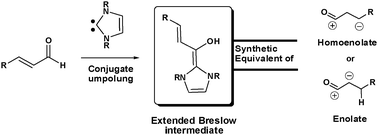Employing homoenolates generated by NHC catalysis in carbon–carbon bond-forming reactions: state of the art
Abstract
Homoenolate is a reactive intermediate that possesses an anionic or nucleophilic carbon β to a

* Corresponding authors
a
Organic Chemistry Section, National Institute for Interdisciplinary Science and Technology (CSIR), Trivandrum 695 019, India
E-mail:
vijaynair_2001@yahoo.com
Fax: +91 471 2491712
Tel: +91 471 2490406
b Organic Chemistry Division, National Chemical Laboratory (CSIR), Dr Homi Bhabha Road, Pune, India
c Department of Chemistry, Texas A & M University, Texas TX-77842-3012, USA
Homoenolate is a reactive intermediate that possesses an anionic or nucleophilic carbon β to a

 Please wait while we load your content...
Something went wrong. Try again?
Please wait while we load your content...
Something went wrong. Try again?
V. Nair, R. S. Menon, A. T. Biju, C. R. Sinu, R. R. Paul, A. Jose and V. Sreekumar, Chem. Soc. Rev., 2011, 40, 5336 DOI: 10.1039/C1CS15139H
To request permission to reproduce material from this article, please go to the Copyright Clearance Center request page.
If you are an author contributing to an RSC publication, you do not need to request permission provided correct acknowledgement is given.
If you are the author of this article, you do not need to request permission to reproduce figures and diagrams provided correct acknowledgement is given. If you want to reproduce the whole article in a third-party publication (excluding your thesis/dissertation for which permission is not required) please go to the Copyright Clearance Center request page.
Read more about how to correctly acknowledge RSC content.
 Fetching data from CrossRef.
Fetching data from CrossRef.
This may take some time to load.
Loading related content
